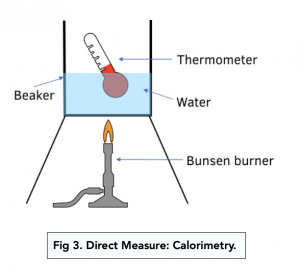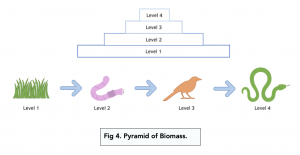Measuring Biomass (A-level Biology)
Measuring Biomass
Measuring Biomass
Biomass is the mass of organic material per unit volume. We can measure biomass of organisms both directly and indirectly.
Direct Measure: Calorimetry
- We can use calorimetry to directly measure biomass. We can directly measure the biomass by burning a sample of the organism in a calorimeter. The sample has to be dry.
- We can measure the energy released during burning. We can estimate the chemical energy store by measuring the amount of energy released (in J or kJ) during burning. This is using the energy to heat a large beaker of water. We can then use the specific heat capacity of water to find out the amount of energy transferred to the water, and thus the amount of energy released from burning, and thus the amount of energy stored.
- There are some limitations in this experiment. There are some limitations to this experiment, so the final value will be an underestimate, because:
-
-
- All of the sample may not be burnt.
- Some of the heat released will be lost to the surroundings.
- Some of the heat released will be used to heat the beaker / container holding the water.
- The water may not be pure, so the specific heat capacity may not be 100% accurate.
-

Indirect Measure: Dry Mass
- We can use dry mass to indirectly measure biomass. We can measure the dry mass of an organism. It has to be dry because some organisms have more water than others, so the water is removed before measurement.
- The sample is dried in heat. A very hot temperature in a chamber is used to dry a small sample of the organism (not the whole organism!).
- Biomass is mass per unit area or volume. The value at the end of the dry mass experiment will be given as something like kg per unit area, or kg per unit volume.
- We can make a pyramid of biomass. We can measure the biomass of each trophic level by multiplying the dry mass of a sample (from that level) by the total population in that level.

Measuring biomass in A-Level Biology is the process of determining the amount of organic matter in a sample of living organisms. Biomass is a measure of the total organic matter in an ecosystem, including the living and dead plant and animal matter, as well as the organic material in the soil.
Measuring biomass is important in A-Level Biology because it provides information about the productivity and biodiversity of an ecosystem. Biomass is a key indicator of the health and stability of an ecosystem, and it can be used to monitor changes in the ecosystem over time.
Measuring biomass in A-Level Biology can be done through a variety of methods, including:
Drying and Weighing: This method involves drying the sample and then weighing it to determine the biomass.
Destruction of Organic Material: This method involves destroying the organic material in the sample and then measuring the amount of carbon or nitrogen left behind.
Direct Measurement of Photosynthesis: This method involves measuring the amount of oxygen produced during photosynthesis, which is directly proportional to the biomass of the plant.
The limitations of measuring biomass in A-Level Biology include:
Difficulty in Sampling: It can be difficult to obtain a representative sample of the entire ecosystem, which can affect the accuracy of the biomass measurement.
Destruction of Samples: Some methods of measuring biomass involve destroying the sample, which can limit the ability to study the organism or ecosystem in the future.
Variability in Biomass: The biomass of an organism or ecosystem can vary greatly over time, making it difficult to obtain a precise measurement.
The applications of measuring biomass in A-Level Biology include:
Studying Ecosystems: Measuring biomass can be used to study the productivity and biodiversity of an ecosystem, and to monitor changes in the ecosystem over time.
Evaluating Agricultural Systems: Biomass measurement can be used to evaluate the effectiveness of agricultural systems and to make decisions about land use and management.
Monitoring Climate Change: Biomass measurement can be used to monitor the effects of climate change on ecosystems and to track changes in carbon sequestration.
The different methods of measuring biomass in A-Level Biology include drying and weighing, destruction of organic material, and direct measurement of photosynthesis.
The significance of measuring biomass in A-Level Biology is that it provides important information about the productivity and biodiversity of an ecosystem. Biomass measurement can be used to study changes in the ecosystem over time, to evaluate agricultural systems, and to monitor the effects of climate change on ecosystems. By understanding the biomass of an ecosystem, we can make informed decisions about land use and management, and work to protect and conserve the ecosystem for future generations.






Still got a question? Leave a comment
Leave a comment